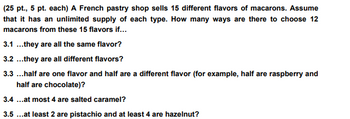
Microsoft Visual C#
7th Edition
ISBN: 9781337102100
Author: Joyce, Farrell.
Publisher: Cengage Learning,
expand_more
expand_more
format_list_bulleted
Question

Transcribed Image Text:For each of the following problems, you should write your answer as an expression. Do not
give the final numeric value. For example, if your answer is the number of
6-permutations of a set with 10 elements, you should write P(10,6) or 10!/4! or 10 × 9 × 8 ×
7 × 6 × 5, but not 151200.

Transcribed Image Text:(25 pt., 5 pt. each) A French pastry shop sells 15 different flavors of macarons. Assume
that it has an unlimited supply of each type. How many ways are there to choose 12
macarons from these 15 flavors if...
3.1...they are all the same flavor?
3.2 ...they are all different flavors?
3.3 ...half are one flavor and half are a different flavor (for example, half are raspberry and
half are chocolate)?
3.4...at most 4 are salted caramel?
3.5 ...at least 2 are pistachio and at least 4 are hazelnut?
Expert Solution
This question has been solved!
Explore an expertly crafted, step-by-step solution for a thorough understanding of key concepts.
Step by stepSolved in 2 steps with 13 images

Knowledge Booster
Similar questions
- The implementation of a queue in an array, as given in this chapter, uses the variable count to determine whether the queue is empty or full. You can also use the variable count to return the number of elements in the queue. On the other hand, class linkedQueueType does not use such a variable to keep track of the number of elements in the queue. Redefine the class linkedQueueType by adding the variable count to keep track of the number of elements in the queue. Modify the definitions of the functions addQueue and deleteQueue as necessary. Add the function queueCount to return the number of elements in the queue. Also, write a program to test various operations of the class you defined.arrow_forward(Numerical) Write a program that tests the effectiveness of the rand() library function. Start by initializing 10 counters to 0, and then generate a large number of pseudorandom integers between 0 and 9. Each time a 0 occurs, increment the variable you have designated as the zero counter; when a 1 occurs, increment the counter variable that’s keeping count of the 1s that occur; and so on. Finally, display the number of 0s, 1s, 2s, and so on that occurred and the percentage of the time they occurred.arrow_forwardA(n) __________ contains 8 __________.arrow_forward
Recommended textbooks for you
 Microsoft Visual C#Computer ScienceISBN:9781337102100Author:Joyce, Farrell.Publisher:Cengage Learning,
Microsoft Visual C#Computer ScienceISBN:9781337102100Author:Joyce, Farrell.Publisher:Cengage Learning, EBK JAVA PROGRAMMINGComputer ScienceISBN:9781337671385Author:FARRELLPublisher:CENGAGE LEARNING - CONSIGNMENT
EBK JAVA PROGRAMMINGComputer ScienceISBN:9781337671385Author:FARRELLPublisher:CENGAGE LEARNING - CONSIGNMENT C++ Programming: From Problem Analysis to Program...Computer ScienceISBN:9781337102087Author:D. S. MalikPublisher:Cengage Learning
C++ Programming: From Problem Analysis to Program...Computer ScienceISBN:9781337102087Author:D. S. MalikPublisher:Cengage Learning- Programming Logic & Design ComprehensiveComputer ScienceISBN:9781337669405Author:FARRELLPublisher:Cengage
 C++ for Engineers and ScientistsComputer ScienceISBN:9781133187844Author:Bronson, Gary J.Publisher:Course Technology Ptr
C++ for Engineers and ScientistsComputer ScienceISBN:9781133187844Author:Bronson, Gary J.Publisher:Course Technology Ptr Programming with Microsoft Visual Basic 2017Computer ScienceISBN:9781337102124Author:Diane ZakPublisher:Cengage Learning
Programming with Microsoft Visual Basic 2017Computer ScienceISBN:9781337102124Author:Diane ZakPublisher:Cengage Learning

Microsoft Visual C#
Computer Science
ISBN:9781337102100
Author:Joyce, Farrell.
Publisher:Cengage Learning,

EBK JAVA PROGRAMMING
Computer Science
ISBN:9781337671385
Author:FARRELL
Publisher:CENGAGE LEARNING - CONSIGNMENT

C++ Programming: From Problem Analysis to Program...
Computer Science
ISBN:9781337102087
Author:D. S. Malik
Publisher:Cengage Learning

Programming Logic & Design Comprehensive
Computer Science
ISBN:9781337669405
Author:FARRELL
Publisher:Cengage

C++ for Engineers and Scientists
Computer Science
ISBN:9781133187844
Author:Bronson, Gary J.
Publisher:Course Technology Ptr

Programming with Microsoft Visual Basic 2017
Computer Science
ISBN:9781337102124
Author:Diane Zak
Publisher:Cengage Learning